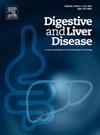Early HBV and HDV kinetics in patients undergoing liver transplantation
IF 3.8
3区 医学
Q1 GASTROENTEROLOGY & HEPATOLOGY
引用次数: 0
Abstract
Background and Aims
Hepatitis B virus (HBV) graft infection occurs after liver transplantation (LT) despite viral source removal and prophylactic treatment. We aimed to elucidate mechanisms and timing of HBV/hepatitis delta virus (HDV) reinfection by analysing early viral kinetics in serum and tissue.
Methods
Serial serum and liver samples were prospectively collected peri- and post-transplant in 12 HBV (5 HDV coinfected) LT recipients. Kinetics of different viral markers were analysed.
Results
HBV-DNA, HDV-RNA, HBsAg and HDAg were detected in all liver explants, while cccDNA was only detectable in HBV monoinfected patients. Residual serum HBV-DNA was detectable before LT in 5 patients but became undetectable a few hours after the anhepatic phase. HBsAg levels were low (<3logIU/mL) in HBV monoinfected patients and cleared fast (within 5 days) in those receiving hepatitis B immune globulin (HBIG) compared to those who did not (within 6 months). In HDV coinfected patients (all receiving HBIG), HBsAg clearance was fast (within 12 hours) if baseline HBsAg <3logIU/mL and slow (within 6 months) if baseline HBsAg >3logIU/ml. HDV-RNA kinetics paralleled that of HBsAg. Post-transplant biopsies, obtained at reperfusion, 3 and 12 months after LT, tested negative for all viral markers (including cccDNA), except for one patient with detectable intrahepatic HDV-RNA and HDAg at 3 months post-LT with undetectable HBV and HDV serum markers.
Conclusion
Despite varying kinetics of HBsAg clearance following LT, we did not detect intrahepatic HBV markers at different time points following transplantation. In contrast, HDV could be sporadically detected in the liver graft, highlighting the need to evaluate new prophylactic strategies in HDV coinfected patients awaiting LT.
肝移植患者早期HBV和HDV动力学
背景和目的乙肝病毒(HBV)移植物感染发生在肝移植(LT)后,尽管病毒源清除和预防性治疗。我们旨在通过分析血清和组织中的早期病毒动力学来阐明HBV/丁型肝炎病毒(HDV)再感染的机制和时间。方法前瞻性收集12例HBV(5例HDV合并感染)肝移植患者移植前后的血清和肝脏样本。分析了不同病毒标记物的动力学。结果所有肝移植体均检测到shbv - dna、HDV-RNA、HBsAg和HDAg, cccDNA仅在单HBV感染患者中检测到。5例患者在肝移植前可检测到残留血清HBV-DNA,但在无肝期后数小时无法检测到。HBV单感染患者的HBsAg水平较低(3logIU/mL),与未接受乙肝免疫球蛋白(HBIG)治疗的患者(6个月内)相比,接受乙肝免疫球蛋白(HBIG)治疗的患者清除速度快(5天内)。在HDV合并感染的患者(均接受HBIG治疗)中,如果基线HBsAg为3logIU/mL,则HBsAg清除速度快(12小时内),如果基线HBsAg为3logIU/mL,则清除速度慢(6个月内)。HDV-RNA动力学与HBsAg相似。移植后再灌注、移植后3个月和移植后12个月的活检显示,除一名患者在移植后3个月可检测到肝内HDV- rna和HDAg外,所有病毒标志物(包括cccDNA)均为阴性,但HBV和HDV血清标志物未检测到。结论:尽管肝移植后HBsAg清除的动力学变化,我们没有在移植后的不同时间点检测到肝内HBV标志物。相比之下,在肝移植物中可以偶尔检测到HDV,这突出了对等待肝移植的HDV合并感染患者评估新的预防策略的必要性。
本文章由计算机程序翻译,如有差异,请以英文原文为准。
求助全文
约1分钟内获得全文
求助全文
来源期刊

Digestive and Liver Disease
医学-胃肠肝病学
CiteScore
6.10
自引率
2.20%
发文量
632
审稿时长
19 days
期刊介绍:
Digestive and Liver Disease is an international journal of Gastroenterology and Hepatology. It is the official journal of Italian Association for the Study of the Liver (AISF); Italian Association for the Study of the Pancreas (AISP); Italian Association for Digestive Endoscopy (SIED); Italian Association for Hospital Gastroenterologists and Digestive Endoscopists (AIGO); Italian Society of Gastroenterology (SIGE); Italian Society of Pediatric Gastroenterology and Hepatology (SIGENP) and Italian Group for the Study of Inflammatory Bowel Disease (IG-IBD).
Digestive and Liver Disease publishes papers on basic and clinical research in the field of gastroenterology and hepatology.
Contributions consist of:
Original Papers
Correspondence to the Editor
Editorials, Reviews and Special Articles
Progress Reports
Image of the Month
Congress Proceedings
Symposia and Mini-symposia.
 求助内容:
求助内容: 应助结果提醒方式:
应助结果提醒方式:


